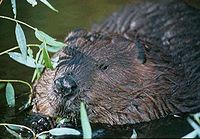Castoroidea
| Castoridae Temporal range: Late Eocene–Recent |
|
|---|---|
 |
|
| North American beaver, Castor canadensis | |
| Scientific classification | |
| Kingdom: | Animalia |
| Phylum: | Chordata |
| Class: | Mammalia |
| Order: | Rodentia |
| Suborder: | Castorimorpha |
| Family: |
Castoridae Hemprich, 1820 |
| Genera | |
|
See text |
|
See text
The family Castoridae contains the two living species of beavers and their fossil relatives. This was once a highly diverse group of rodents, but is now restricted to a single genus, Castor.
Castorids are medium-sized mammals, although large compared with most other rodents. They are semiaquatic, with sleek bodies and webbed hind feet, and are more agile in the water than on land. Their tails are flattened and scaly, adaptations that help them manoeuvre in the water. Castorids live in small family groups that each occupy a specific territory, based around a lodge and dam constructed from sticks and mud. They are herbivores, feeding on leaves and grasses in the summer, and woody plants such as willow in the winter. They have powerful incisors and the typical rodent dental formula:
The earliest castorids belong to the genus , known from the late Eocene and Oligocene of North America and Asia. Other early castorids included genera such as Steneofiber, from the Oligocene and Miocene of Europe, the earliest member of the subfamily Castorinae, which contains castorids closely related to living beavers. Their teeth were not well suited to gnawing wood, suggesting this habit evolved at a later point, but they do appear adapted to semiaquatic living. Later, such early species evolved into forms such as Palaeocastor from the Miocene of Nebraska. Palaeocastor was about the size of a muskrat, and dug corkscrew-shaped burrows up to 2.5 m (8.2 ft) deep.
Giant forms evolved in the , including Trogontherium in Europe, and Castoroides in North America. The latter animal was as large as a black bear, yet had a brain only marginally larger than that of modern beavers. Its shape suggests it would have been a good swimmer, and it probably lived in swampy habitats.
...
Wikipedia
